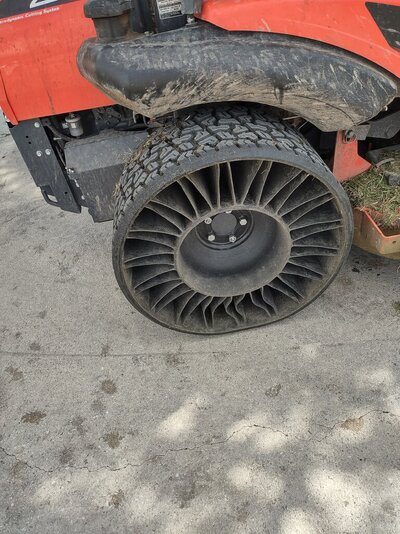You are using an out of date browser. It may not display this or other websites correctly.
You should upgrade or use an alternative browser.
You should upgrade or use an alternative browser.
I wish they had these tire for motorhomes.
- Thread starter DonTom
- Start date
The friendliest place on the web for anyone with an RV or an interest in RVing!
If you have answers, please help by responding to the unanswered posts.
If you have answers, please help by responding to the unanswered posts.
Laura & Charles
Well-known member
I saw tires like those on a mower just a couple days ago.
ButchW
Well-known member
I wonder about the life expectancy of these things?...
Butch
Butch
Ray-IN
Well-known member
Ya, but it was only flat on one side_. Bias ply tires are still recommended for trailers, but radial is cheaper to make, so guess which wins at trailer mfgrs.The pressure on those tire ribs has to be on the order of 800-1200 lbs, so I think that frozen snow & ice would crack off as the wheel turns. But it's not going to be instantaneous and there must be extreme conditions where this could be an issue. At least for a half-mile or so.
I remember back in the day when nylon was introduced for the sidewalls on the bias-ply tires used back then. It was a great material for high mileage and puncture resistance, but the semi-flat bottom portion of the tire would get stiff as a board when it sat for several hours in winter temperatures. It rode like a flat tire (which it literally was) until the tire warmed up from the flexing.
The first test cars to get Michelin airless tires is a fleet of Chevy Bolt EV cars. Michelin Re-Introduces Puncture Proof Airless Tire
Last edited:
Adventurous Traveler
Well-known member
If they became available for the RV industry, I'm guessing you would see them on trucks and semis first.
As with any new technology, I would think the price of them would be out of the ballpark for most, if not all of us.
Pretty cool looking though.
As with any new technology, I would think the price of them would be out of the ballpark for most, if not all of us.
Pretty cool looking though.
DonTom
Well-known member
That Chevy Bolt looks exactly like mine, same color and all. I wonder if I will be able to install such tires on my Bolt.Chevy Bolt
I hope there is a way for me to turn off my Bolt's TPMS.
-Don- Reno, NV
Ray-IN
Well-known member
Tread is replaceable on the Michelin design.I wonder about the life expectancy of these things?...
Butch
The tough thing about these airless tires is, what's guys gonna argue about when discussing ride quality; Load/inflation chart air pressure or mfgrs. recommendation?
Chef Duane
Well-known member
And whaddya' gonna' do when you're just a skuuuunch too high for the low bridge? Not like you can airdown.Tread is replaceable on the Michelin design.
The tough thing about these airless tires is, what's guys gonna argue about when discussing ride quality; Load/inflation chart air pressure or mfgrs. recommendation?
Wasillaguy
Well-known member
This still happens with modern radials when you get down to around -30F and it sits overnight.I remember back in the day when nylon was introduced for the sidewalls on the bias-ply tires used back then. It was a great material for high mileage and puncture resistance, but the semi-flat bottom portion of the tire would get stiff as a board when it sat for several hours in winter temperatures. It rode like a flat tire (which it literally was) until the tire warmed up from the flexing.

